Chapter 23: 17th century Art in Europe
1/14
There's no tags or description
Looks like no tags are added yet.
Name | Mastery | Learn | Test | Matching | Spaced |
|---|
No study sessions yet.
15 Terms
Describe the baroque period
new society of the Jesuit order
earth wasn’t the center of the universe
ruler’s economic strength began to slip and artist found patrons in the church and the secular state and in the urban middle class
“barocco” a jeweler term for a irregular shaped pearl:beautiful fascinating and strange
-the art evokes intense emotional response from viewers.
-Dramatically lit, theatrical compositions often combine several media within a single work as artist highlight their technical virtuosity
own version of classicism, a more moving and dramatic variant of Renaissance principles. featuring idealization based on observation of the material world balance composition; diagonal movement in space; harmonious colours; ancient references to greece and Rome
Genre painting"(scenes from everyday life)
still life, religious scene with ordinary ppl in ordinary settings
Italian renaissance:role of viewers changed, kepst viewers at a distant allowing reflection on what was being seen
Artist wanted to engage viewers as participants in the work, like audience in a theatre
Carlo Maderno and Gianlorenzo Bernini ST. PETER'S BASILICA AND PIAZZA,
VATICAN, ROME
Maderno, façade, 1607-1626; Bernini, piazza design, c. 1656-1657
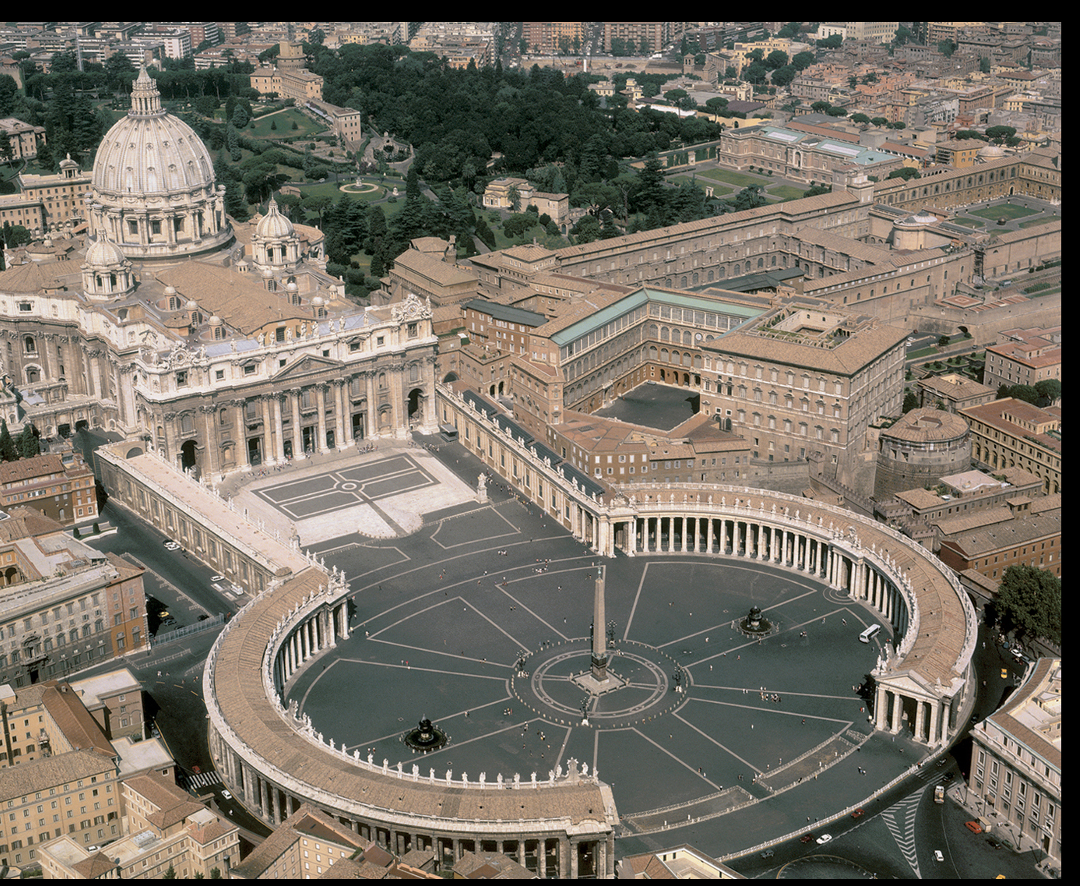
Gianlorenzo Bernini BALDACCHINO(canopy)
St. Peter's Basilica, Vatican, Rome. 1624-1633.
Gilt bronze, height approx. 100' (30.48 m). Chair of Peter shrine, 1657-1666; gilt bronze, marble, stucco, and glass. Pier decorations, 1627-1641; gilt bronze and marble.
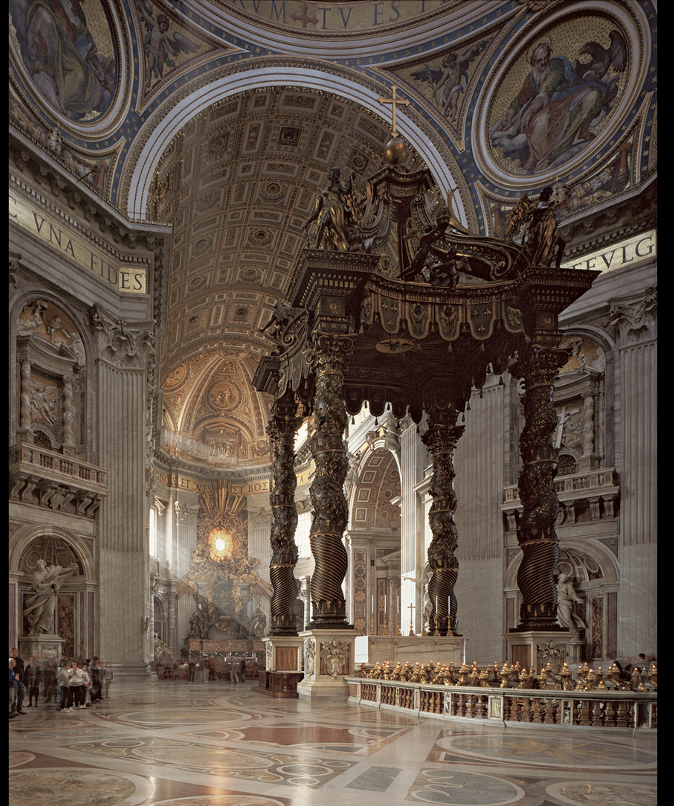
embalish the church an its settings
built colony to enclose the piazza, indoor ooutdoor
like extending arms and comforting the people
Egyptian Obelisk
Giant column as male personification of power
embracing history
½ cent after Michelangelo returned to St-peter’s Basilica to Bramates original vision, pope Paul V Borghese commissioned Carlo Madero to provide the church with a longitude nave and a new facade
began 1607 and everything but facade bell tower were completed by 1615.
inspired by Il Gesu’s facade this facade steps forward in 3 progressively projecting planes;from corners to the doorways flanking the central entrance area, then entrance area, the the central doorway.
Colossal orders connecting the 1st and 2nd stories are flat pilasters at the corners but fully round columns flank doorways. These column support a continuous entablature that steps out as it moves toward the central door
Baldachin: Modera dies 1629 so Gianlorenzo Bernini succeeded him as Vatican architect.He was taught by his father which involved sketching that Vatican collection of ancient sculpture and painting at the papal palace.
He admire art and was a classicist, developed a new baroque style
Urban VIII was pope in 1623 gave Bernini the task to make the Baldaccino over altar at St-Peter’s.
Church was large and needed a focus
100ft and exemplifies the baroque multimedia work like combining architecture, sculpture, and painting
Gigantic corner columns symbolize union of christanity and jewish tradition;the vine of Eucharist climbs the twisted columns associate with solomon. Supporting an entablature with crowning elemntes topped with orb(universe) and a cross(reign of chris)
Angels and putti decorate entablature which is hung with tassleed panels imitating a cloth canopy
Marks toomb of sT-PETER AND TRIBUTE TO urban VIII and his family whos w=emblem are isplayed(honey bees, suns on panels and laurel leaves on climbing vines)
1627-1641 Bernin and sculptor rebuilt Bramates crossing piers as giant reliquaries
Stautue stand in niches below alcoves containg relics on left and right of the baldaccino
Through the baldaccino columns of the apse of the church a the chair of peter symbolizing the decent of christian authorty from peter to current pope which is a rejected belief by protestants
Above shrine stained glass window portrays holy spirit as a dove surrounded by oval golden rays
Gilde angels and gilted bronze rays around window and seem to penetrate the natural light into the apse of the church
gilding reflect back to window for a etheral effect seen as activation of divinity
Infront of ste peter: Building of Colonnade forms a huge double piazza. Irregular open space, Egyptian obelisk and fountain had to be worked wit
2 curved porticos supported by tuscan columns which connect to 2 straight porticos. which lead up a slight incline to 2 ends of facade known as”maternal arms of the church”
Paiting in the 17th cent followed which 2 paths
ordered classicism of the Carracci family or dramatic naturalism of Caravaggio
mostly northern italian
Caravaggio BACCHUS
1595-1596. Oil on canvas,
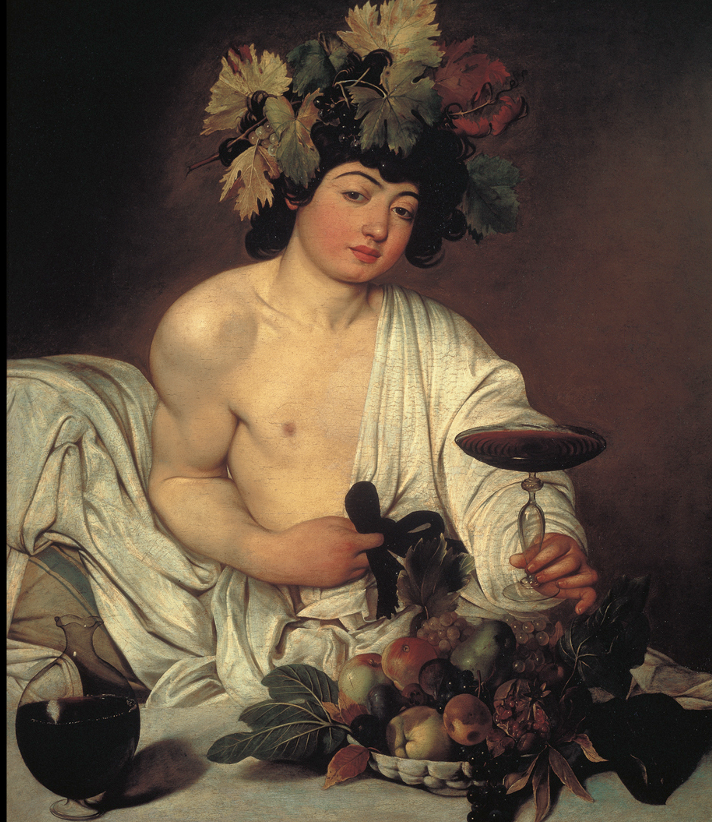
Caravaggio studied under master but never held atelier, very alone and dualed people.Very talents working on contrast
finger are dirt and you can tell hes a hard worker
youth in costume, realism
push and pull with realism
modern for the time
can’t tell where the settings are
tenebrism=figures being illuminated by a single light source
Frank realism and dramatic , theatrical lighting and gesture
still life painting, half length figures
he painted for small sophisticated circl with the household of art patron Cardinal del Monte, where he lived
Still life and genre scenes featuring fortune tellers, cardsharps, glamorous men as musicians or mythological figures.
Painted exaclty what he saw, reproducing farmers tan and dirt under nails
Figure is androgynous
Painted lips and and arching eybrows as he offers viewers a goblet f wine while fingering the blck bow
May be a provocative invintation to and erotic encounter or a young actor outfitted for the role of Bacchus, god of wine, Juxtaposition of the youths invintation with the still life of rotting fruit may add a message about transitory nature of sensual pleasure either admonishing viewers to avoid sins of the flesh or encouraging them to enjoy life’s pleasure while they can
Ambiguity add provocativeness
Caravaggio and what an art style he used
He was a rebellious painter , killed someone over a dual
used tenebrism=forms emerge from a dark background into a strong light that often falls from a single source, theatrical spotlight
Artemisia Gentileschi JUDITH BEHEADING HOLOFERNES
c. 1619-20. Oil on canvas,
,Florence
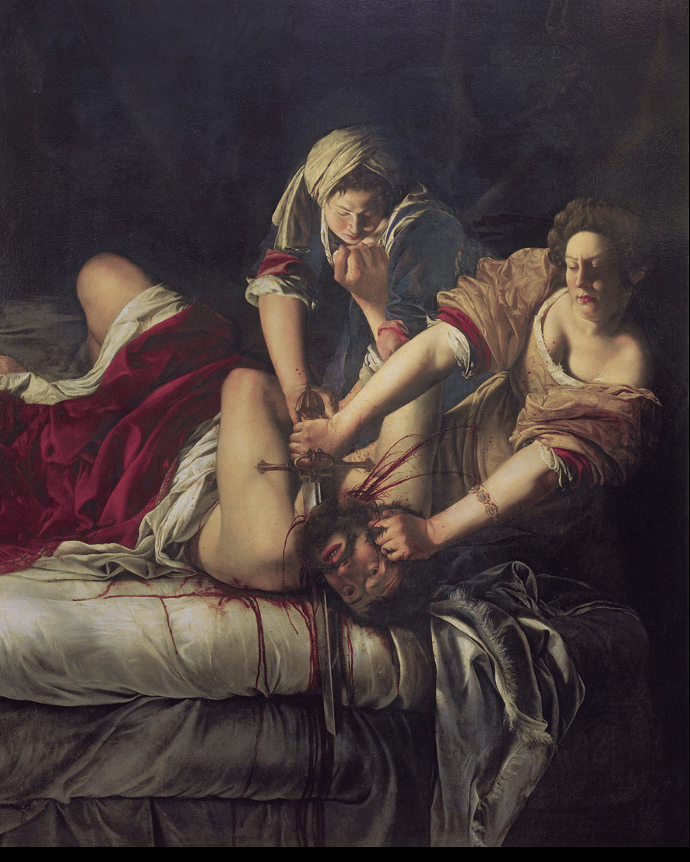
.
female artist, studied under father and brother
s\a women excurting her revenge shower her empowerment through her subject matter.
story of rape and sexual assau;t
Incredible tension ad work
Cadaver
one of Caravaggio’s followers which helped spread the caravaggesque style beyond rome
Studies under father Orazio an earlier follower
1616 moved from Rome to Florence where she worked for grand Duke Cosimo II de’Medici and was elected at 23 to Florentine Academy of Design
Clear tenebrism and naturalism
gave to Cosimo II before she left florence back to Rome
Subject from biblical book of Judith which recounts the story of the destructive invasion of Judah by the Assyrian general. Holofernes, when the brave Jewish widow Judith risked her life to save her ppl
judith uses her charm to enter his tent with her maidservent while he is drunk and beheads him with his own sword
Emphasize the grisly facts as the women struggle to hold Holofernes and blood spues from necks
Dramatic spotlight, convergence of compositional diagonal rivets our attention to foreground
Throughout her life would paint heroic biblical women in relation to her own struggle of being a woman in a male dominant field
Counter reformation gave what guidelines for painting Mary
dressed in blue and white, hands folded in prayer as she is carried upward by angels.Surrounded by unearthly light stand on moon
Diego Velázquez LAS MENINAS (THE MAIDS OF HONOR)
1656. Oil on canvas,
Museo del Prado, Madrid.
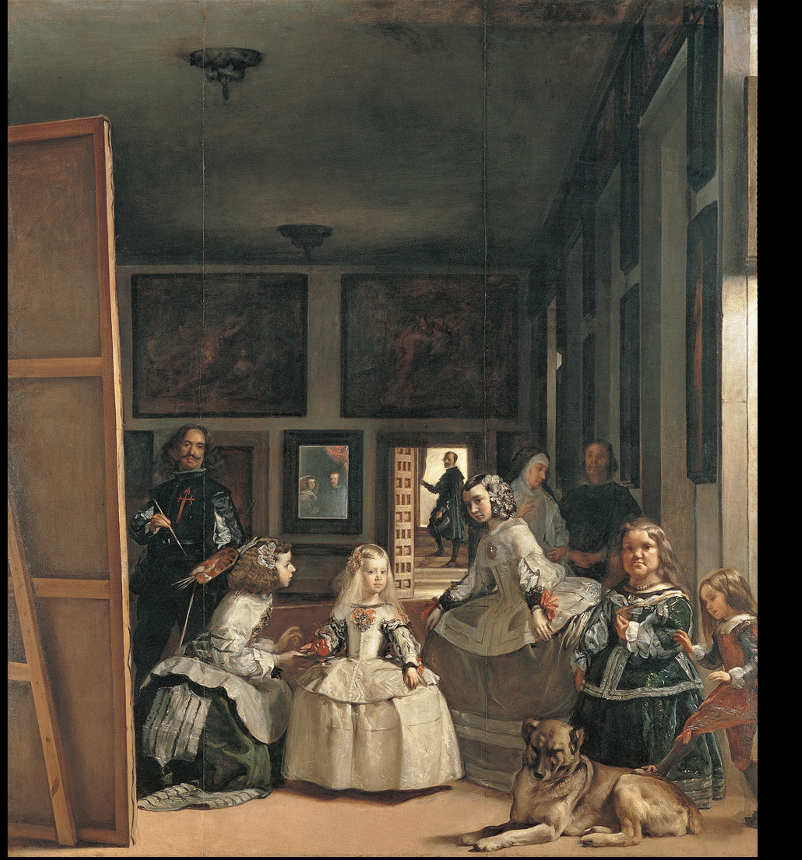
Velázquez most enigmatic work,multiple portrait
painted near the end of his life
challenges viewers and debath among historians
raws viewers directly through the scene
one interpretation: the viewer stands in the space occupied by King Philip and his queen whos reflection can be seen in mirror perhaps reference to Jan Eycks douvle portraits
Echoin Jan pictoral claim he is also present, beside canvas
Central focus is 5 year old Infanat Margarita who is surround by attendants, most of whom are identifiable
Unsure of meaning
Royal portrait and self portrait of Velázquez standing at ease and personal statement
Velázquez had sought respect and acclaim for himself and for the art of painting
Dressed as a courtier, order of santiago on chest, keys tucked in sash he proclaims dignity and importance of painting himself
Leyster is known for what
Informal scenes of daily life
narrow range of colour narrowly dispersed in the composition and warm spotlight
Describe the Technique: Etching and Drypoint
•Rembrandt popularized etching, which is an intaglio technique(design carved out of the surface of surface of the printing plate) that carves designs out of the surface of a printing plate.Metal plate coated with acid-resistant resin
§Metal is coated with an acid-resistant resin, then scratched into.
•Drypoint is another intaglio technique in which a sharp needle directly scratches into the metal.
etching-acid to inscribe a design on metals
Drypoint-sharp needle to scratch shallow lines in a plate
Both allow direct on the plate which has a free and spontaneous character of drawing
what is Impasto
heavily applied paint
rembrandt:
what is camera obscura
cameralike box used to record images from the real world. It enhances optical distortion that led to the beading of highlight
ex:Verneer, View of Delft
Johannes Vermeer WOMAN HOLDING A BALANCE
c. 1664. Oil on canvas,
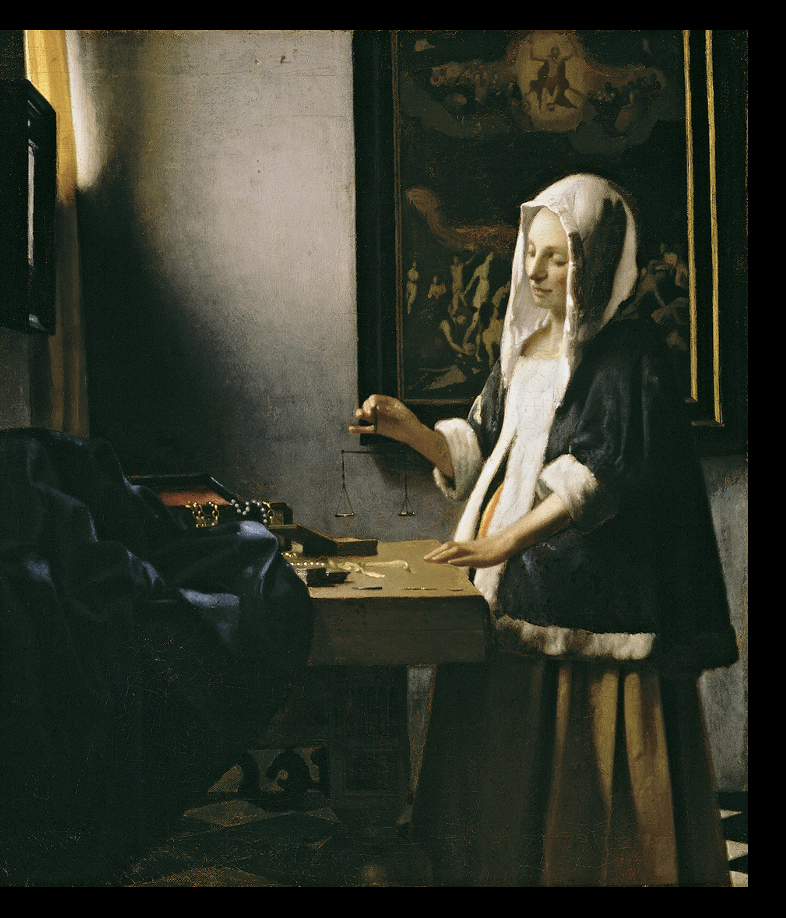
-most of vermeer;s painting pportrays enigmatic scenes of women in their homes,alone, or with servant occupied with a refined activity
-quiet and still interior scene gentle in color, asymmetrical but strongly geometric in organization
Turned everyday scene to unearthly perfection by creating a contained and consistent architectonic world
pearly light from window give solidity to figures
evokes a mood of quiet meditation
Controlled brushwork, almost invisible unless it is characteristic pools of reflected light as tiny droplets of color
-painting: studies equilibrium creates a monumental composition and a moment of stillness
Woman contemplating balance in right hand, drawing our attention to the act of weighing and judging.
Hand and scale central, behind her is the last judgement highlighting figure of chris the judge in a gold oval above her head
Juxtaposition. turn scene into a metaphor for eternal judgement, a sobering religious reference that may reflect the artist own posistion as a catholic living in a protestant country
Woman’s moment of introspection in front of the gold and pearls display on the table shimmering evokes the vanitas theme of the transience of earthly life.
Versaille
Louis Le Vau and Jules Hardouin-Mansart GARDEN FAÇADE OF THE PALACE OF VERSAILLES
1678-1685. Foreground: Jean-Baptiste Tuby Neptune.
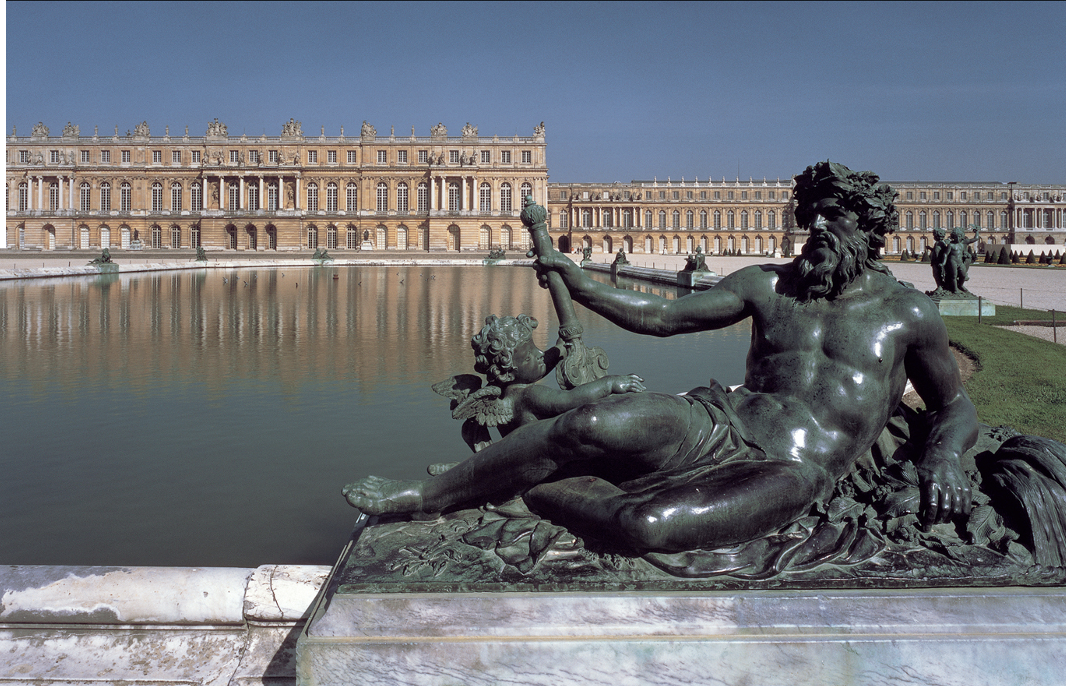
Jules Hardouin-Mansart and Charles Le Brun HALL OF MIRRORS, PALACE OF VERSAILLES
Begun 1678.
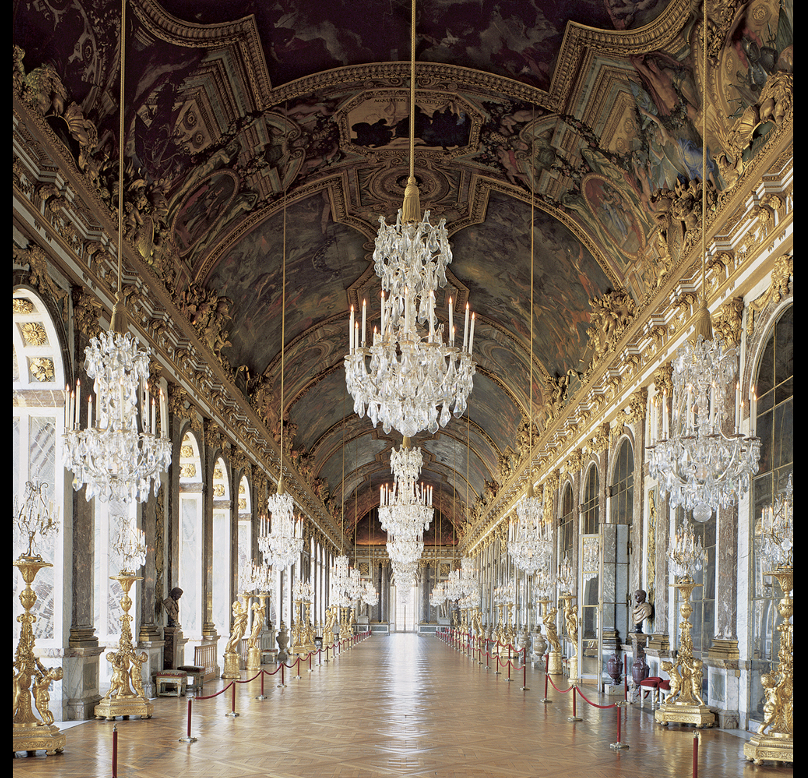

Design based that math was the true basis of beauty
1668 Loui XIV began to enlarge small chateau built by Louis XIII. New building went around it.
2 phases: 1st addition by Le Vau in 1668; 2nd enlargemnt after his death by successor Jules Hardouin Mansart
Palace used for entertainment and landscape architecture rivals no other.water feature.geometry, canals,14 water wheels
Garden facade: Hardouin-Mansart did the addition of long lateral wings and renovation of Le Vau’s central block on the garden side to match these wings. 3 story facade has rusticated ground floor, main floor with lined with enormous arched windows which are flanked by pilasters and flat terraced roof.
Design is a sensitive balance of horizontal and verticals relieved by restrained overlay of regurlar spaced projecting blockes with open colonnaded porches
HALL OF MIRRORS: Hardouin-Mansart enclosed the previous open gallery on the main level creating the hall.Architectural symmetry and a sense of splender and expansiveness by lining interior walls with glass mirror, matching size and shape of arched windows in the opposing wall.
mirror were small and expensive therefore created by fitting 18 inch panels together
reflected the natural light and gives impression of a larger space; night time with flickering candles turned the hall shimmering tableau which the king and courtier saw themselves promenade
Louis Le Vau and André Le Nôtre PLAN OF THE GARDENS OF THE PALACE OF VERSAILLES
Versailles, France. c. 1661-1785.
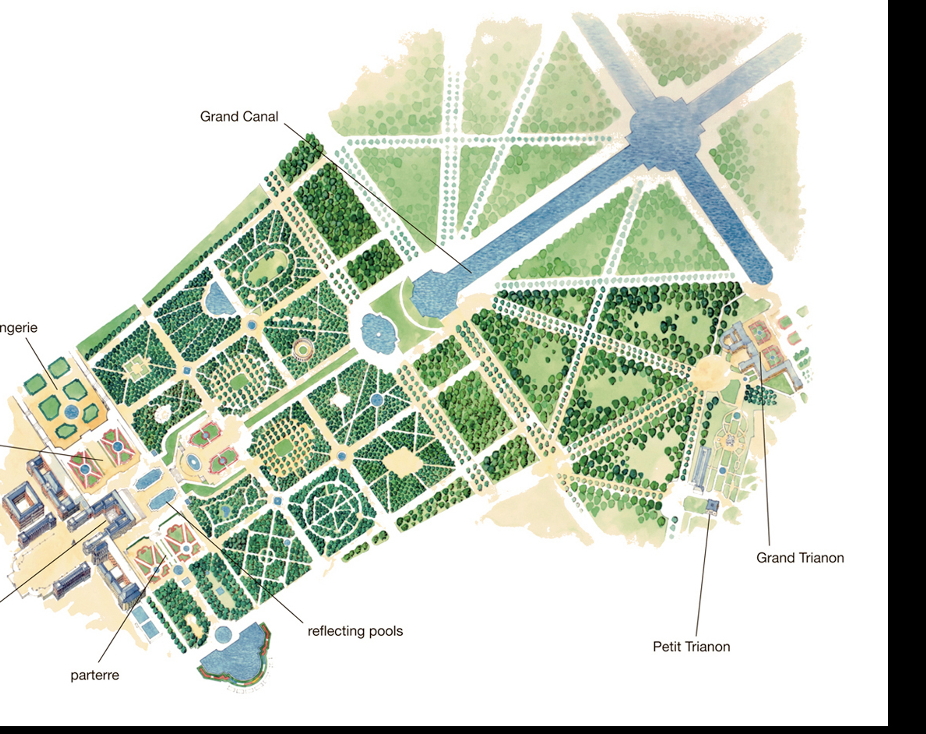
artistocratic french landowner commissioned garden designers to transform properties in gardens over acres.
challenge to unify nuildings,pools,mouments, plantings and natural land formation into acoherant whole
André Le notre imposed order upon the vast expanses of the palace gardens an park by using broad, straight avenues radiating from round focal points.Inspiring generations of urban design and landscape architecture
Work of art and visual delight
gardens are harmonious in their symmetrical, geometric design and garden thickened into the woods but by straight avenues
Formal garden nearest to palace and plantings are less elaborate and larger in scale as they get further from palace
Embroidered Parterres:broad intersecting paths seperated reflecting pools and planting beds, colorful pattern of flowers with trimmed hedges
after formal parterre is lawn, large fountain on terraces and trees to cover features
70 sculpture sculpted
mile long canal, crossed by 2nd canal
1400 fountains
north end fd 2nd canal a small pavilion palace the Trianon build in 1669 bedding with blooming plants shipped from south
gardener to have 2 million pots at disposal
18th cent louis XV added greenhouse and botanical garden